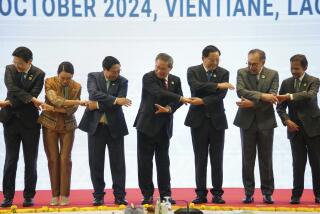Spratly Spat Heats Up Over Chinese ‘Bullying’
- Share via
MANILA — China’s recent construction of “fishermen shelters” in the Spratly Islands off the Philippine coast has heightened regional tensions and raised concerns in Southeast Asia that Beijing is seeking to expand its military influence.
The increased Chinese activity in the strategic island chain was detected last month by Philippine reconnaissance planes. In addition to the concrete garrison-style structures, pilots reported seeing antiaircraft gun emplacements, a helipad, radar facilities, a landing strip and an air-raid shelter.
U.S. Rep. Dana Rohrabacher (R-Huntington Beach) made six passes over the islands last week in a C-130 provided by the Philippine armed forces and photographed Chinese warships deployed near Mischief Reef. Docks and structures on the reef apparently were being expanded.
“We can’t ignore this bullying by the Communist Chinese in the Spratlys,” Rohrabacher told reporters. “The presence of the Chinese military troops . . . is not only a concern of the Philippines. It is also a concern of the U.S. and other democratic countries in the world.”
The Spratlys, 310 miles west of the Philippines, are located in the South China Sea, along strategic navigation lanes linking the Indian and Pacific oceans, and are believed to hold large deposits of oil and natural gas. They are claimed in whole by China, Taiwan and Vietnam; in part by the Philippines, Malaysia and Brunei.
In response to what much of Southeast Asia perceives as a Chinese threat, the Philippines has lodged a diplomatic protest with Beijing and stepped up naval patrols and reconnaissance flights over the chain of hundreds of tiny islands, reefs, shoals and sandbanks. Its ships and planes have been ordered to keep their distance so as not to provoke an incident.
The 10 nations of Southeast Asia have long been leery of the giant economic and military shadow China casts over the region. Leaders of the regional grouping, the Assn. of Southeast Asian Nations, are meeting in Hanoi today and Wednesday and plan to voice their concerns over the Spratlys with Chinese Vice President Hu Jintao during the summit, Philippine sources said.
One paragraph of a draft statement ASEAN leaders will consider delivering at the conclusion of the summit says “despite the positive developments in the South China Sea, China has undertaken actions which violate international laws, including the United Nations Convention on the Laws of the Sea,” said Philippine Foreign Affairs Undersecretary Lauro Baja Jr.
The country’s foreign affairs secretary, Domingo Siazon, told the Philippine Senate in November that China’s recent buildup was part of its defense plan for the 21st century, aimed at extending “beyond East Asia. . . . They are looking at covering the Pacific.”
China says the facilities on Mischief Reef are not for military use but for fishermen--20 of whom Manila arrested last month and charged with illegal fishing. Manila officials said the Chinese fishermen placed sodium cyanide in the fertile fishing waters. This kills some fish and stuns other prized varieties, such as grouper, allowing the fishermen to sell them alive to expensive restaurants in Hong Kong and Japan.
The Spratlys, extending for hundreds of miles north to south, were briefly occupied during World War II by the Japanese, who used some of the islands for submarine bases.
China began to establish a limited presence in the islands in January 1988, and months later fought a short-lived naval battle with Vietnam over the islands. In October 1993, Vietnam completed a lighthouse in the Spratlys to establish a claim to sovereignty.
The Philippines began settling fishermen in the Spratlys 30 years ago for the same reason, and they now have a mayor and vote in national elections. The United States has no position on the territorial claims.
More to Read
Sign up for Essential California
The most important California stories and recommendations in your inbox every morning.
You may occasionally receive promotional content from the Los Angeles Times.










